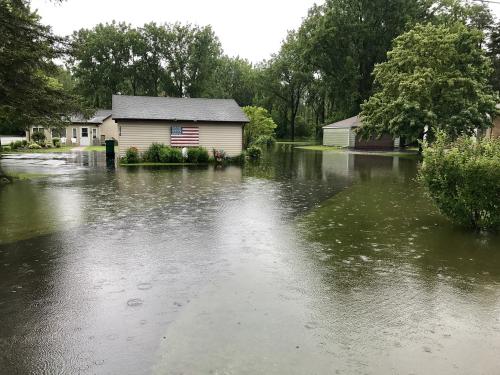Michigan Sea Grant storm project seeks to help communities prepare for future extreme storms
Mid-Michigan's 2017 storm reminiscent of the 1986 Great Flood.

On June 22 and 23, 2017 mid-Michigan was hit by a large rain event. The storm dropped 7.29 inches of rain in Mount Pleasant, 6 inches in Midland, and 3.08 inches in Bay City.
Pictures of damage in Bay, Isabella, Saginaw, and Midland counties show flooded roads, washed out culverts, damaged bridges, flooded homes, businesses, and flooded agricultural fields. Bay, Isabella and Midland counties were declared states of emergency allowing them to receive help from the state. The damages from this storm are as yet, unknown, but the 1986 Flood in the Saginaw Bay area caused about $500 million in damages.
Michigan Sea Grant and its partners have been working on a project to bring heightened awareness of extreme storms and to provide information to communities on preparing for such storms. While these suggestions are too late to help with this severe storm, there are actions communities might consider for the future in order to lessen the effects of extreme storms.
Preserve wetlands
One of the crucial functions of a wetland area is to hold excess water during storm events and let it go slowly, usually through evaporation or flowing down into the ground water table. Wetlands can hold a lot of water and that can mitigate storm impacts. This Michigan Department of Environmental Quality Wetlands Map Viewer helps identify wetland areas around the state.
Green infrastructure
Many developments are designed with hard materials that rain quickly runs off from and into rivers and combined storm sewers. One way to help mitigate the impact of extreme storms is to hold water on our properties in productive ways, sort of like wetlands. Rain gardens, bioswales (similar to rain gardens but designed to handle a larger amount of water), permeable pavers, green roofs, and green spaces are all ways that communities can help hold back water and reduce runoff. The Environmental Protection Agency offers a website with information to developing green infrastructure.
Protect floodplains
Rivers and streams can only hold so much water until the water flows over the bank and into an area’s natural floodplain. Leaving floodplains undeveloped is one way to store this water. Development in these areas removes the floodplain space and that water must go somewhere, which increases the impact elsewhere.
Properly construct culverts, bridges
During extreme storm events culverts and bridges are often damaged as they may not be large enough to withstand for the water overflow. The Michigan Department of Environmental Quality (DEQ) has a minor permit category for large culverts that require the structure to be built to several specific criteria including spanning a minimum of bankfull width.
Flood Insurance
Many people don’t realize they may need flood insurance. The Federal Emergency Management Agency provides insurance to property owners and also encourages communities to adopt floodplain management regulations.
The Saginaw Bay watershed is particularly vulnerable to storm hazards because of the region’s unique topography and land-use patterns. A c omplex network made up of 7,000 miles of rivers and streams, the Saginaw Bay watershed drains roughly 15 percent of the state of Michigan. This massive watershed includes both urban and agricultural lands. Because the watershed covers such a large flat area, extreme storm impacts are quickly magnified. Communities within the Saginaw Bay watershed face a major challenge in adapting to increased frequency and intensity of storm events. The website 1986flood.com shows the impact this storm had on the area and offers additional ways to prepare for extreme storms.
omplex network made up of 7,000 miles of rivers and streams, the Saginaw Bay watershed drains roughly 15 percent of the state of Michigan. This massive watershed includes both urban and agricultural lands. Because the watershed covers such a large flat area, extreme storm impacts are quickly magnified. Communities within the Saginaw Bay watershed face a major challenge in adapting to increased frequency and intensity of storm events. The website 1986flood.com shows the impact this storm had on the area and offers additional ways to prepare for extreme storms.
Having some of these infrastructure designs and practices in place may not be enough to stop the impact of a 7-inch rain event, but it could help mitigate the impacts during storm events. Michigan Sea Grant plans to continue outreach and education and will be providing webinars and a workshop in the fall of 2017 to help communities assess their coastal storm resiliency planning needs.
Michigan Sea Grant helps to foster economic growth and protect Michigan’s coastal, Great Lakes resources through education, research and outreach. A collaborative effort of the University of Michigan and Michigan State University and its MSU Extension, Michigan Sea Grant is part of the NOAA-National Sea Grant network of 33 university-based programs.



 Print
Print Email
Email




